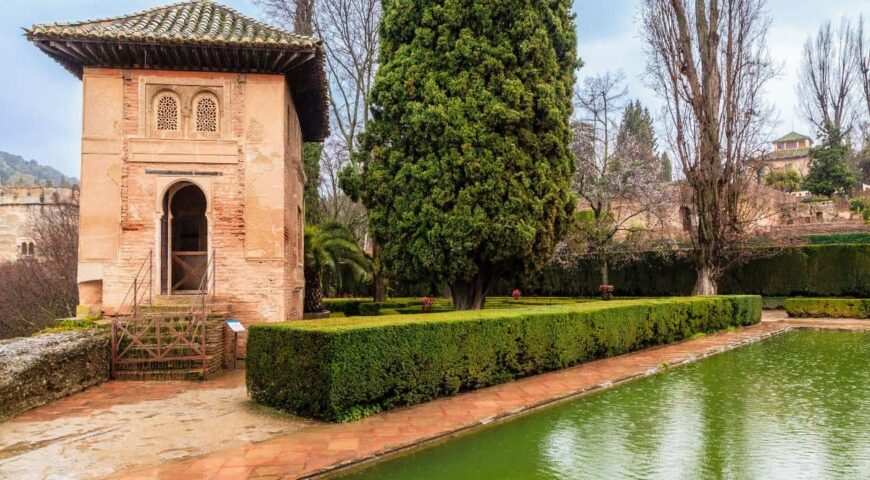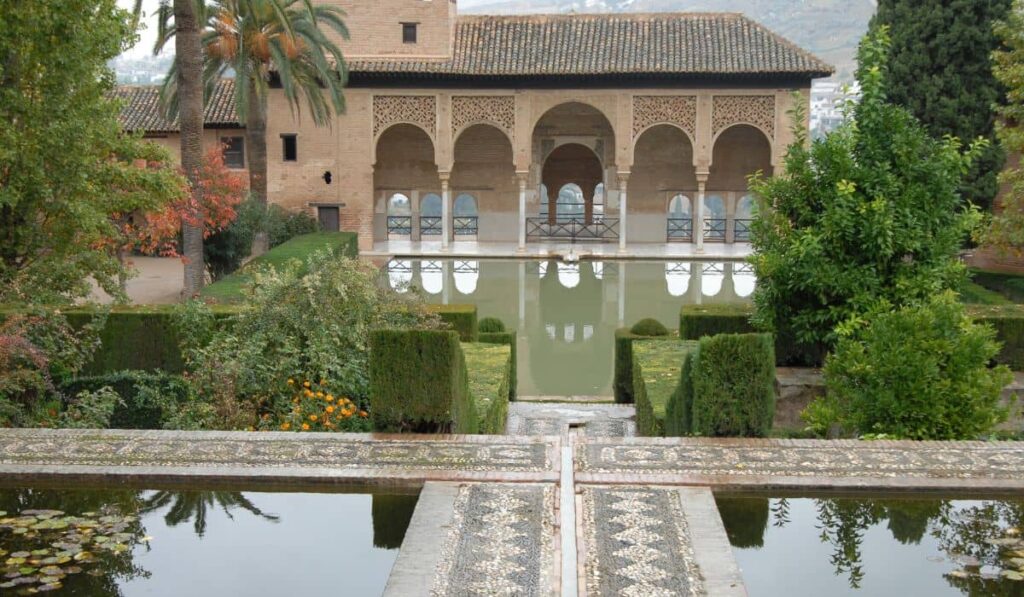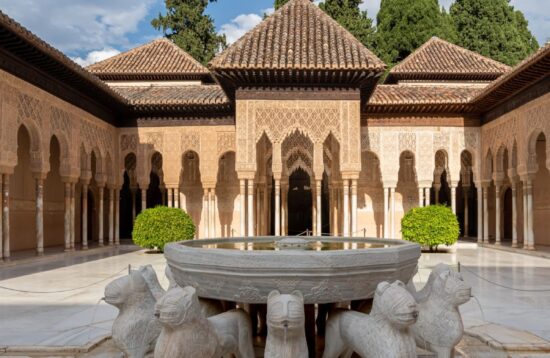
Partal Gardens of the Alhambra, an unforgettable place
The Partal Gardens, a hidden treasure within the majestic Alhambra complex in Granada, Spain, is a true paradise of serenity and beauty. Nestled in a dreamlike setting, these historic gardens transport us to a bygone era, where the harmony between nature and architecture reaches its maximum expression. With their elegant ponds, lush vegetation and panoramic views of the city, the Partal Gardens captivate visitors with their timeless charm. Discover the history, symbolism and unique experience that these gardens offer amidst the splendor of the Alhambra.
History and context
The Partal Gardens, located within the majestic Alhambra complex in Granada, Spain, is a haven of beauty and tranquility that holds centuries of history. These gardens date back to the 14th century, during the time of the Nasrid Kingdom of Granada, and have witnessed numerous transformations over time.
The Partal Gardens are an integral part of the overall design of the Alhambra, which combines Islamic and Renaissance elements, creating a magnificent example of Andalusian architecture and gardening. These gardens are located in the lower part of the complex, framed by the Water Tower and the Palace of Yusuf III.
The name “Partal” derives from the Arabic word “barat-al-hamma”, which means “bathing pool”. In fact, the gardens are characterized by elegant ponds and water channels, which were considered essential both for ornamental purposes and to provide freshness and irrigation to plants and flowers.
Over the centuries, the Partal Gardens have been influenced by various cultures and architectural styles. During the Nasrid period, the gardens followed the typical design of Persian gardens, with ponds and fountains surrounded by abundant vegetation. However, after the conquest of Granada by the Catholic Monarchs in 1492, significant changes were introduced in the Alhambra and its gardens. The Renaissance influence became evident, and elements such as sculptures, statues and terraces were added.
In the broader context of the Alhambra, the Partal Gardens play an essential role in the design of the complex. The Alhambra was built as a royal fortress and palace, and the gardens were designed to reflect the close connection between nature and political and religious power. These gardens were a place of retreat and rest for the Nasrid monarchs, where they could enjoy the beauty of nature while taking refuge from the responsibilities and stresses of court life.
In terms of design, the Partal Gardens are characterized by their stepped terraces, which adapt to the topography of the terrain. This allows for panoramic views of the city of Granada and the surrounding valley, providing a sense of harmony between the landscape and the architecture.

Cultural significance and symbolism of the Partal Gardens
The Partal Gardens, beyond their undeniable aesthetic beauty, are imbued with a deep cultural significance and symbolism that reflect the worldview and values of the era in which they were conceived. These gardens were not only a space for visual delight and contemplation, but also played a crucial role in the daily life and ceremonial activities of the Alhambra.
The careful arrangement of architectural elements and the selection of vegetation in the Partal Gardens are based on a series of intrinsic symbolisms and meanings. For example, the ponds and water channels represent the idea of fertility and life, and also symbolize irrigation and the importance of water as a vital resource in an arid region. The flow of water through these gardens conveys a sense of serenity and harmony, inviting visitors to contemplation and inner peace.
The symmetry and geometry present in the design of the gardens have a significant importance in the cultural context of the time. These architectural elements reflect the idea of order and balance, and are believed to have been associated with the Islamic conception of divine perfection. The careful symmetrical design of the gardens and the precision in the placement of fountains and courtyards represent a reflection of cosmic harmony and the interconnection between the human and divine worlds.
The selection of vegetation also has a deep symbolism. The trees and plants used in the Partal Gardens were carefully chosen for their cultural significance and symbolism. For example, cypresses, with their tall, stylized form, were considered symbols of eternity and were used to create a vertically harmonious visual effect. Roses, with their delicate beauty and fragrance, were symbols of love and beauty in Islamic culture.
These gardens were also places of great importance in the ceremonial and social activities of the Alhambra. They were used for the celebration of important events, such as receptions and banquets, where monarchs and nobility met with foreign dignitaries and prominent members of the court. The gardens provided an idyllic and serene setting for these gatherings, and their symbolic design helped to enhance the majesty of the occasions.
In the daily life of the Alhambra, the Partal Gardens were also spaces where monarchs and nobility found peace. These gardens offered a place of retreat and rest, where rulers could escape the hustle and bustle of court life and connect with the natural beauty that surrounded them. The gardens become oases of tranquility and contemplation, allowing moments of introspection and connection with the divine.
Visitor Experience
When exploring the Partal Gardens at the Alhambra, visitors enter an oasis of serenity and beauty that offers a unique experience. Here are some practical tips to make the most of your visit and fully enjoy this wonderful historical gem:
Plan your visit
The Alhambra and its gardens are a popular tourist attraction, so it is advisable to plan ahead. Book your tickets in advance, as access to the Partal Gardens is included in the general Alhambra ticket. Check the official Alhambra website for opening and closing times, as well as current access restrictions.
Recommended Routes
When exploring the Partal Gardens there are several recommended routes that will allow you to discover every corner and enjoy different perspectives. You can start at the top of the gardens, from where you will get a panoramic view of the city of Granada and the valley. Then, walk down the terraces and stroll along the tree-lined paths, exploring the ponds and admiring the architecture. Follow the directions and maps provided so you don’t miss anything.
Best times to visit the Partal Gardens
The Partal Gardens are beautiful at any time of day, but there are certain times that can offer a special experience. At the beginning of the day or towards the end of the afternoon, the soft light enhances the colors and textures of the gardens, creating a magical atmosphere. In addition, these times tend to be less crowded, allowing you to enjoy greater tranquility and have a more intimate experience with your surroundings.
Other interesting aspects
In addition to the gardens themselves, take the opportunity to enjoy the panoramic views they offer. From the Partal Gardens, you will be able to admire the city of Granada and the surrounding mountains, giving you a unique perspective. In addition, the Alhambra organizes special events on occasion, such as concerts and open-air theatrical performances. Find out about the events scheduled during your visit to further enrich your experience.
Respect and care for the Partal Gardens
When exploring the Partal Gardens, remember to respect the environment and follow the established rules. You are not allowed to step on the vegetation or touch the historic structures. Also, pick up your trash and respect the tranquility of the place so that all visitors can fully enjoy it.
Exploring the Partal gardens is an enriching experience that transports you to another era. We recommend you to go with a tour guide to not miss any detail about your visit to the Alhambra as it will give you a unique perspective and immerse you in the exciting past of this iconic place!





